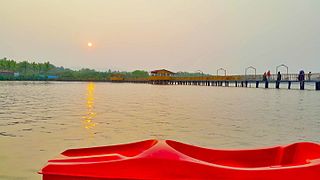
Kannur is one of the 14 districts along the west coast in the state of Kerala, India. The city of Kannur is the district headquarters and gives the district its name. The old name, Cannanore, is the anglicized form of the Malayalam name "Kannur". Kannur district is bounded by Kasaragod District to the north, Kozhikode district to the south, Mahé district to the southwest and Wayanad District to the southeast. To the east, the district is bounded by the Western Ghats, which forms the border with the state of Karnataka. The Arabian Sea lies to the west. Paithalmala is the highest point in Kannur District (1,372m). Enclosed within the southern part of the district is the Mahé district of the Union Territory of Puducherry. The district was established in 1957.
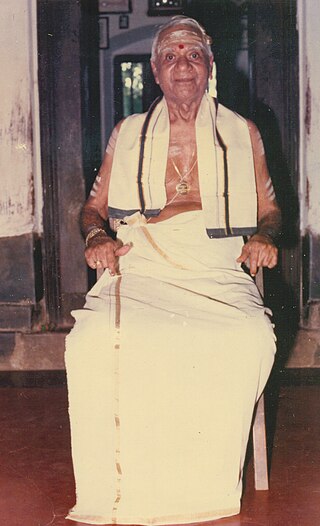
Guru Mani Madhava Chakyar (15 February 1899 – 14 January 1990) was a celebrated master performance artist and Sanskrit scholar from Kerala, India, considered to be the greatest Chakyar Koothu and Koodiyattam artist and authority of modern times. He was considered as the authority of Abhinaya and Nātyaśāstra.

Sangeet Natak Akademi is the national level academy for performing arts set up by the Government of India.
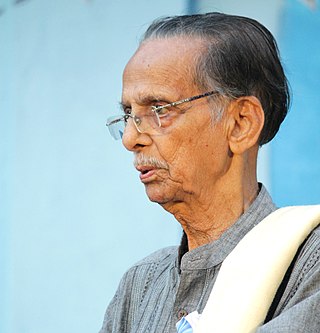
Kavalam Narayana Panicker was an Indian dramatist, theatre director, and poet. He has written over 26 Malayalam plays, many adapted from classical Sanskrit drama and Shakespeare, notably Kalidasa's Vikramorvasiyam, Shakuntalam (1982), Bhasa's Madhyamavyayogam (1979), Karnabharam, Uru Bhangam (1988), Swapnavasavadattam, and Dootavakyam (1996). He was the founder – director of theatre troupe, Sopanam, which led to the foundation of Bhashabharati: Centre for Performing Arts, Training and Research, in Trivandrum.

Madathil Vasudevan, popularly identified as M. V. Devan, was an Indian painter, sculptor, writer, art critic and orator. Besides his artistic works, he was also known for his architectural designs for a number of cultural institutions as well as for his contributions in founding Kerala Kalapeetom, Kochi-based cultural organization, Malayala Kalagramam, an art village in New Mahe and Kalagramam, another art village in Kollam. A former chairman of the Kerala Lalithakala Akademi, he was a recipient of several honours including the Raja Ravi Varma Puraskaram of the Kerala Lalithakala Akademi, the Vayalar Award and the Mathrubhumi Literary Award.

Prof. Kadammanitta Vasudevan Pillai, is a Padayani exponent from Kerala, India. He is the former Vice Chairman of the Kerala Folklore Academy, a professor in mathematics, a writer and public speaker.

Kottakkal Sivaraman was a performing artiste who revolutionised the portrayal of female roles in Kathakali, the classical dance-drama from Kerala in southern India.
Kalamandalam Krishnan Nair was a Kathakali dancer from Kerala in India.

Kalamandalam Ramankutty Nair was a performer of Kathakali, who practiced the Kerala art form for more than seven decades.
Keezhpadam Kumaran Nair (1916–2007) was a Kathakali artists from Kerala, India. Endowed and equip with a life profile that also show him to several traditional Indian performing arts other than Kathakali, his stage presentation infused a fresh breath into the four-century-old art form, thanks also to his broad and deep view about the Puranas that spurred from a constant pursuit of knowledge through reading books and engaging in talks in scholars.

B. Sasikumar was an Indian Carnatic music violinist, musician, teacher, composer and writer from Thiruvananthapuram, Kerala.

Tripunithura Viswanathan Gopalakrishnan, known as TVG, is a Carnatic and Hindustani musician from Cochin, Kerala, India. He was awarded the Madras Music Academy's Sangeetha Kalanidhi in 2014.

Thanu Krishna Murthy, better known as T. K. Murthy, is an Indian mridangam player. Murthy is a Padma Shri and Sangeetha Kalanidhi awardee.

Peruvanam Kuttan Marar is a chenda artist. He leads several popular traditional orchestra performances in Kerala. He received Padma Shri, India's third highest civilian award, in 2011 for his contributions in the field of art.
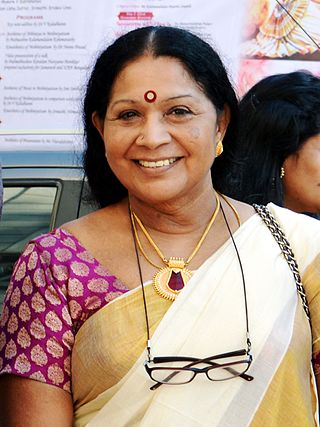
Kalamandalam Kshemavathy is a Mohiniyattam dancer from Thrissur, Kerala. She is an alumna of the Kerala Kalamandalam. She joined the institute when she was ten. After completion of the course, she undertook advanced training in Bharata Natyam under Muthuswamy Pillai and Chitra Visweswaran, and in Kuchipudi under Vempati Chinna Satyam, but chose to remain within the Mohiniyattam tradition.
The Kerala Sahitya Akademi Award for Children's Literature is an award given every year by the Kerala Sahitya Akademi to Malayalam writers for writing children's literature of literary merit. It is one of the twelve categories of the Kerala Sahitya Akademi Award.
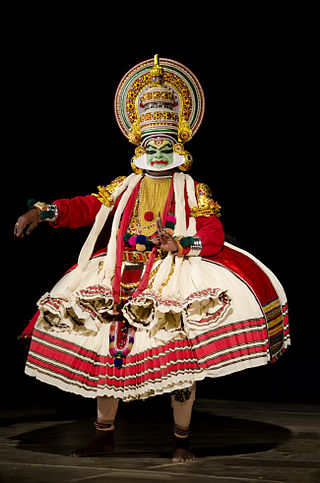
Kavungal Chathunni Panicker (1922-2007) was an Indian classical dancer, known for his proficiency in Kathakali, the traditional dance form of Kerala. He was an exponent of the Kavungal School of Kathakali, noted for its rigorous training methods and overt physical interpretation of abhinaya. He is known to have brought innovations to the dance form, especially in the decorative movements (kalasam) and his contributions are reported in the development of grammar and costumes for the Kavungal School. A recipient of the Sangeet Natak Akademi Award in 1973, Panicker was honored again by the Government of India, in 2006, with the fourth highest Indian civilian award of Padma Shri.
The Kerala Sangeetha Nataka Akademi Fellowship is an honour presented by the Kerala Sangeetha Nataka Akademi, an autonomous organisation for the encouragement, preservation, and documentation of the performing arts of Kerala, set up by the Department of Cultural Affairs of the Government of Kerala. Instituted in 1972, the fellowships are given to outstanding artistes who have contributed to the performing arts in the state. The awardees are decided after a general body meeting conducted by the Akademi panel members and are presented by the Governor of Kerala.
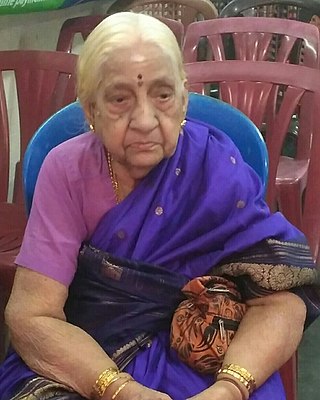
Parassala B. Ponnammal was an Indian Carnatic musician from the south Indian state of Kerala. She was a classical carnatic vocalist in the lineage of Semmangudi Srinivasa Iyer, Muthiah Bhagavathar, and Papanasam Sivan. She was the first woman to perform at the Navaratri Mandapam in Thiruvananthapuram as a part of the Navaratri Celebrations of the Sri Padmanabhaswamy temple in Kerala.

M. V. Vishnu Namboothiri was a teacher, folk art researcher and author from Kerala, India. He was considered an authoritative source of information on Theyyam and other traditional art forms of North Malabar. He received several awards including awards from Kerala Sahitya Akademi, Kerala Folklore Academy and Kerala Sangeetha Nataka Academy.















